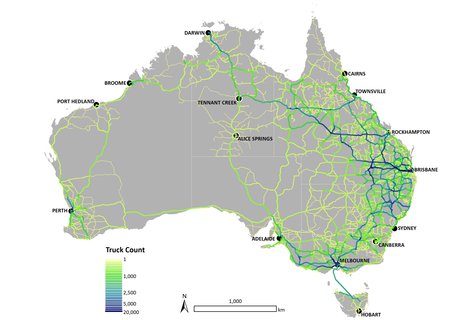Tool for transporting cattle more efficiently

CSIRO has developed a tool that identifies ways to reduce the time and distance it takes to transport cattle around Australia, thus cutting the fuel costs, wear and tear and stress involved in the journey of this valuable commodity.
Northern Australian cattle typically travel an average of around 1000 km, and as much as 2500 km to get to east coast abattoirs. So while the value of the industry is $12 billion in off-farm meat, the transport of the beef between production, processing and markets can make up around 40% of the final market price.
CSIRO researchers set out to evaluate the production system by simulating more than 1.5 million vehicle movements between 50,000 enterprises over five years using some 88,000 point-to-point travel routes. According to lead researcher Dr Andrew Higgins, the team has completed “the most comprehensive mapping of the cattle supply chain in Australia”.
This information was then modelled via CSIRO’s Transport Network Strategic Investment Tool (TRANSIT), which uses it to identify opportunities for infrastructure and policy development and models the likely results. These include more direct transport routes, the development of new processing facilities, increased access for higher productivity vehicles and improved links to rail.
“We can now use TRANSIT to identify key investments, large and small, at critical points in the supply chain, along with policy changes that might allow for better planning,” Dr Higgins said.
In Central Queensland, for example, TRANSIT has modelled the potential benefits of sealing the remaining 105 km of the Hann Highway north of Hughenden. This would apparently reduce travel time on the highway from five hours to three and a half hours, saving about 1160 hours for the estimated 1300 road trains currently using the road per year.
TRANSIT also identified that the number of road trains using the fully sealed Hann Highway would increase by 25%, as it would become an optimal travel route. This would remove heavy vehicles from the congested coastal highways and translate to a modelled cost saving of $1.23 million per year, plus the additional savings from shorter return journeys for empty trucks and benefits to other road users.
“Other advantages from a more efficient supply chain are improved safety and welfare of the live animals and the truck drivers themselves taking these long journeys, reduced emissions and a more sustainable industry at a time of growth,” Dr Higgins said.
TRANSIT is already being applied to the cattle industry Australia-wide, mapping the path of about 60,000 origin-to-destination movements representing 20 million cattle transported in Australia per year. Beyond cattle, the tool can be applied to other commodities like grains, fibre and horticulture.
Merger strengthens RSK Australia's regional services
Projence and Western Project Services have merged under the Projence brand, to improve the...
Reaching net zero in the manufacturing sector
Sustainable solutions such as 'green concrete' and carbon tracking were presented at the...
Reducing upfront carbon in built environment: report
ASBEC has released a report aiming to reinforce and amplify government and industry efforts...










